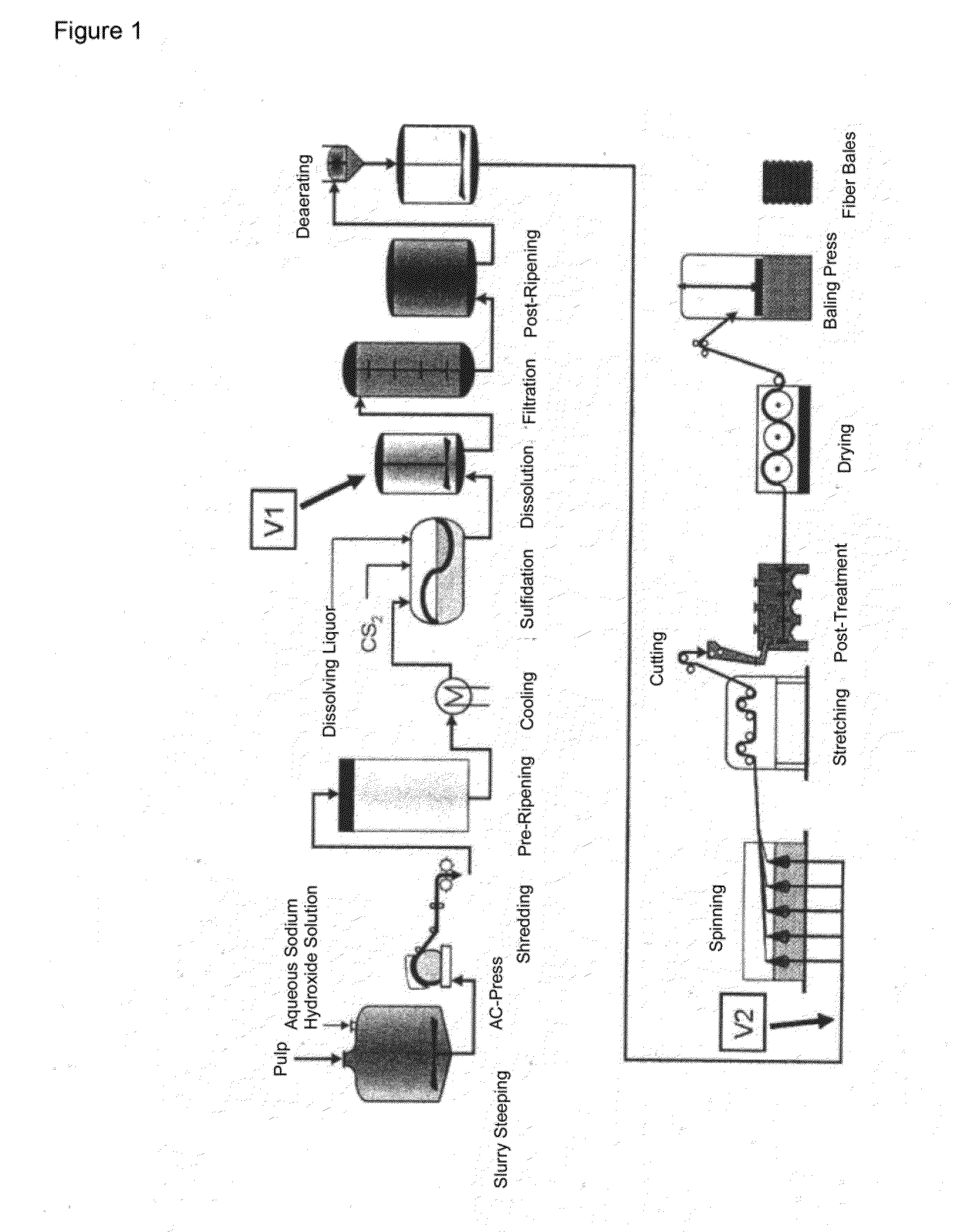Polysaccharide fibers and method for producing same
- Summary
- Abstract
- Description
- Claims
- Application Information
AI Technical Summary
Benefits of technology
Problems solved by technology
Method used
Image
Examples
example 1
[0033]A viscose xanthogenate containing 29.8% by weight of cellulose, 14.9% by weight of alkali, and 8% by weight of sulfur was reacted in a dissolving unit with a first dissolving liquor containing 4.5% by weight of NaOH and then with a second dissolving liquor containing 9% by weight of α(1→3)-glucan and 4.5% by weight of NaOH and finally with water. The viscose obtained in this way contains 9% by weight of fiber-forming material, 5.20% by weight of alkali, and 2.4% by weight of sulfur (calculated under the assumption that there are 100% by weight of cellulose as a fiber-forming material), with a ripeness index of 14 Hottenroth and a falling ball viscosity of 80 seconds (determined according to the Zellcheming Leaflet III / 5 / E). Viscose solutions with 10 and 25% of α(1→3)-glucan were prepared. These glucan quantities were related to the proportion of the α(1→3)-glucan in the fiber-forming substance. These viscose types contain 2.2% by weight of sulfur (10% by weight of glucan and 9...
example 2
[0036]A viscose containing 8.70% by weight of cellulose, 5.20% by weight of alkali, and 2.3% by weight of sulfur, with a ripeness index of 15 Hottenroth and a falling ball viscosity of 75 seconds (determined according to the Zellcheming Leaflet III / 5 / E), was, by means of a spinneret, extruded into a regeneration bath containing 100 g / l of sulfuric acid, 310 g / l of sodium sulfate, and 15 g / l of zinc sulfate. The spinneret had 1053 perforations with a diameter of 50 μm. 0.5% by weight of a nitrogen-containing auxiliary agent were added to the viscose spinning solution. In order to achieve adequate fiber strength, stretching by approx. 75% was carried out in the second bath (92° C., 15 g / l of H2SO4). The draw-off velocity was 50 m / min.
[0037]By using a positive displacement pump, various weight / weight percentages of a α(1→3)-glucan solution (prepared with 5% by weight of NaOH, 8% by weight of α(1→3)-glucan) were added to the viscose solution upstream from the spinneret, and fibers havin...
example 3
[0040]A modal viscose containing 6.0% by weight of cellulose, 6.20% by weight of alkali, and 1.8% by weight of sulfur, with a gamma value of 65 and a falling ball viscosity of 130 seconds (determined according to the Zellcheming Leaflet III / 5 / E) was, by means of a spinneret, extruded into a regeneration bath containing 72 g / l of sulfuric acid, 115 g / l of sodium sulfate, and 55 g / l of zinc sulfate. The spinneret had 1053 perforations with a diameter of 45 μm. 2.5% by weight of a nitrogen-containing auxiliary agent were added to the viscose spinning solution. In order to achieve adequate fiber strength, stretching by approx. 115% was carried out in the second bath (92° C., 15 g / l of H2SO4). The draw-off velocity was 50 m / min.
[0041]By using a positive displacement pump, various weight / weight percentages of a α(1→3)-glucan solution (prepared with 5% by weight of NaOH, 4.5% by weight of α(1→3)-glucan) were added to the viscose solution upstream from the spinneret, and fibers having 5 and...
PUM
| Property | Measurement | Unit |
|---|---|---|
| Fraction | aaaaa | aaaaa |
| Percent by mass | aaaaa | aaaaa |
| Percent by mass | aaaaa | aaaaa |
Abstract
Description
Claims
Application Information
 Login to View More
Login to View More - R&D
- Intellectual Property
- Life Sciences
- Materials
- Tech Scout
- Unparalleled Data Quality
- Higher Quality Content
- 60% Fewer Hallucinations
Browse by: Latest US Patents, China's latest patents, Technical Efficacy Thesaurus, Application Domain, Technology Topic, Popular Technical Reports.
© 2025 PatSnap. All rights reserved.Legal|Privacy policy|Modern Slavery Act Transparency Statement|Sitemap|About US| Contact US: help@patsnap.com

